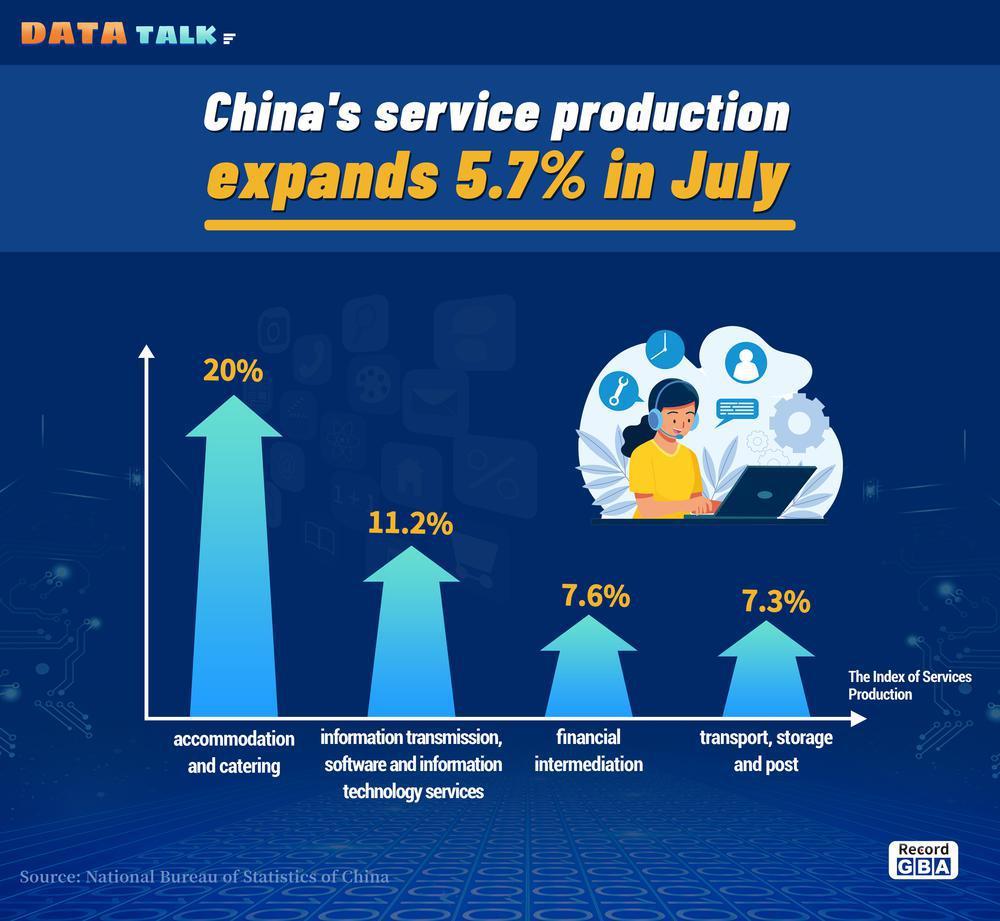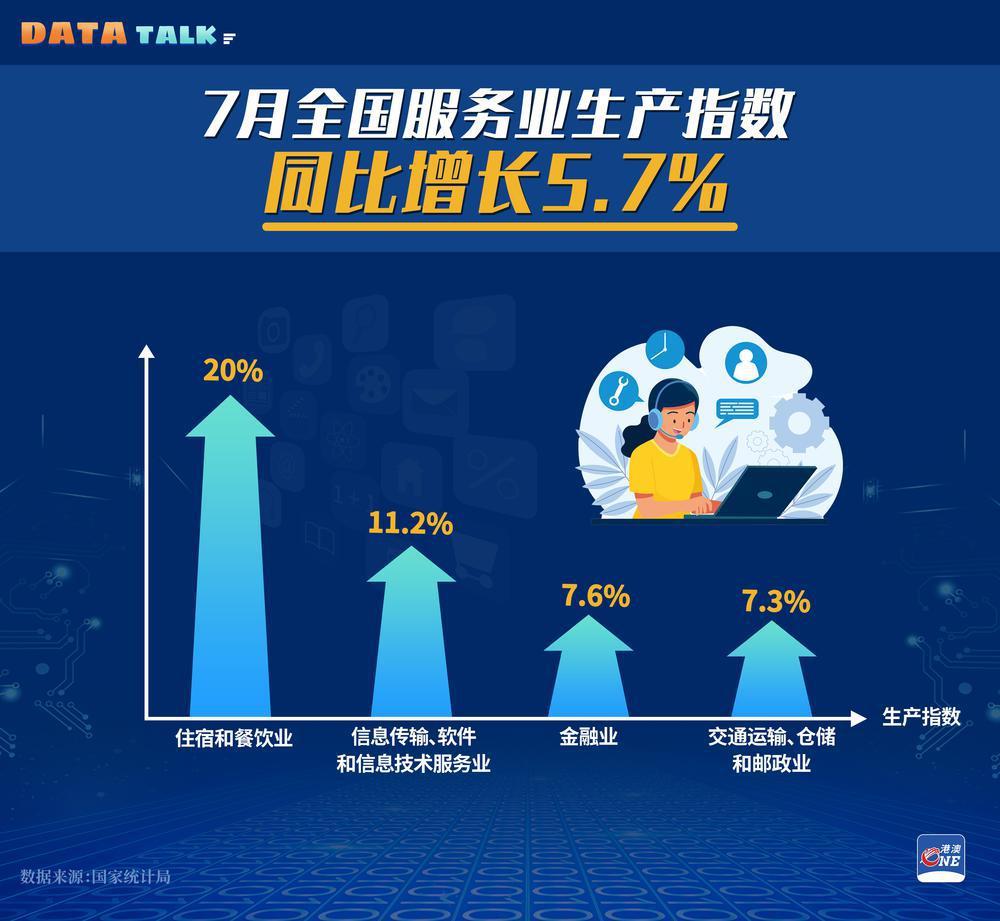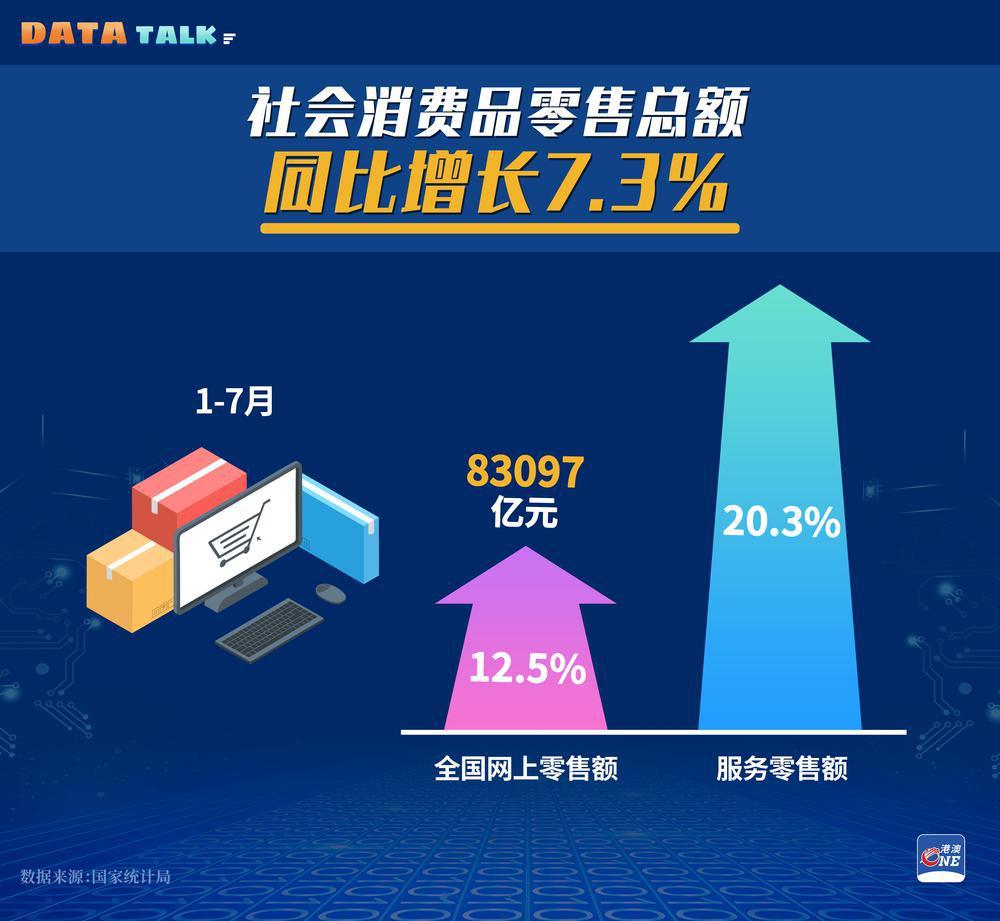



In July, all regions and departments firmly implemented the decisions and arrangements made by the CPC Central Committee and the State Council, adhered to the general principle of pursuing progress while maintaining stability, fully and faithfully applied the new development philosophy on all fronts, accelerated efforts to foster a new pattern of development, intensified the role of macro policies in regulating the economy and focused on promoting high-quality development. As a result, the national economy continued to recover. The production and demand were basically stable, the employment and prices generally held steady and the development quality kept enhancing.
1. Service Sector Maintained Fast Growth with Modern Service Industries Demonstrating Sound Momentum of Growth.
In July, the Index of Services Production increased by 5.7 percent year on year. Specifically, that of accommodation and catering, that of information transmission, software and information technology services, that of financial intermediation and that of transport, storage and post grew by 20.0 percent, 11.2 percent, 7.6 percent and 7.3 percent year on year respectively. In the first seven months, the Index of Services Production increased by 8.3 percent year on year. In the first six months, the business revenue of service enterprises above the designated size went up by 7.5 percent year on year. In July, the Business Activity Index for Services was 51.5 percent, and the Business Activity Expectation Index for Services was 58.7 percent. Specifically, the Business Activity Index for air transportation, express mail services, telecommunication, broadcast, television and satellite transmission services, and Internet, software and information technology services stayed within the high expansion range of 60 percent and above.
2. Industrial Production Grew Steadily and the Growth of Raw Material Manufacturing Picked up.
In July, the total value added of industrial enterprises above the designated size grew by 3.7 percent year on year, or up by 0.01 percent month on month. In terms of sectors, the value added of mining increased by 1.3 percent year on year, manufacturing went up by 3.9 percent and the production and supply of electricity, thermal power, gas and water grew by 4.1 percent. The value added of raw material manufacturing went up by 8.8 percent year on year, or 2.0 percentage points faster than that of the previous month. An analysis by types of ownership showed that the value added of state holding enterprises was up by 3.4 percent year on year; that of share-holding enterprises was up by 5.0 percent; that of enterprises funded by foreign investors or investors from Hong Kong, Macao and Taiwan was down by 1.8 percent; and that of private enterprises was up by 2.5 percent. In term of products, the output of solar cells and new-energy vehicles went up by 65.1 percent and 24.9 percent year on year respectively. In the first seven months, the total value added of industrial enterprises above the designated size went up by 3.8 percent year on year. In July, the Manufacturing Purchasing Managers’ Index stood at 49.3 percent and the Production and Operation Expectation Index was 55.1 percent.
3. Market Sales Continued to Recover and Consumption of Services Went up Fast.
In July, the total retail sales of consumer goods reached 3,676.1 billion yuan, up by 2.5 percent year on year, or down by 0.06 percent month on month. Analyzed by different areas, the retail sales of consumer goods in urban areas reached 3,192.0 billion yuan, up by 2.3 percent year on year; and that in rural areas reached 484.1 billion yuan, up by 3.8 percent. Grouped by types of consumption, the retail sales of goods were 3,248.3 billion yuan, up by 1.0 percent; the income of catering was 427.7 billion yuan, up by 15.8 percent. Of the total retail sales of commodities by units above the designated size, the retail sales of grain, oil and food, that of traditional Chinese medicine and western medicine, that of beverage and that of telecommunication equipment went up by 5.5 percent, 3.7 percent, 3.1 percent and 3.0 percent respectively. In the first seven months, the total retail sales of consumer goods reached 26,434.8 billion yuan, up by 7.3 percent year on year. The online retail sales totaled 8,309.7 billion yuan, up by 12.5 percent year on year. Specifically, the online retail sales of physical goods were 6,985.6 billion yuan, up by 10.0 percent, accounting for 26.4 percent of the total retail sales of consumer goods. The retail sales of services went up by 20.3 percent year on year in the first seven months.
4. Investment in Fixed Assets Continued to Scale up and Investment in High-Tech Industries Grew Fast.
In the first seven months, the investment in fixed assets (excluding rural households) reached 28,589.8 billion yuan, up by 3.4 percent year on year. Specifically, the investment in infrastructure grew by 6.8 percent year on year, that in manufacturing grew by 5.7 percent, and that in real estate development dropped by 8.5 percent. The floor space of commercial buildings sold was 665.63 million square meters, down by 6.5 percent year on year; the total sales of commercial buildings were 7,045.0 billion yuan, down by 1.5 percent. By industry, the investment in the primary industry went down by 0.9 percent year on year, that in the secondary industry up by 8.5 percent, and that in the tertiary industry up by 1.2 percent. The private investment went down by 0.5 percent. The investment in high-tech industries grew by 11.5 percent year on year, of which the investment in high-tech manufacturing and high-tech services grew by 11.5 percent and 11.6 percent respectively. In terms of high-tech manufacturing, the investment in manufacturing of medical equipment, measuring instrument and meter and in manufacturing of electronic and communication equipment grew by 16.0 percent and 13.9 percent respectively. In terms of high-tech services, the investment in services for transformation of scientific and technological achievements and in professional technical services went up by 44.9 percent and 23.8 percent respectively. In July, the investment in fixed assets (excluding rural households) dropped by 0.02 percent month on month.
5. Imports and Exports of Goods Dropped Year on Year and Trade Structure Continued to Optimize.
In July, the total value of imports and exports of goods was 3,456.3 billion yuan, a decline of 8.3 percent year on year. Specifically, the total value of exports was 2,016.0 billion yuan, down by 9.2 percent; the total value of imports was 1,440.3 billion yuan, down by 6.9 percent. The trade balance was 575.7 billion yuan in surplus. In the first seven months, the total value of imports and exports of goods was 23,552.1 billion yuan, an increase of 0.4 percent year on year. Among that, the total value of exports was 13,472.8 billion yuan, up by 1.5 percent; the total value of imports was 10,079.3 billion yuan, down by 1.1 percent. In the first seven months, the imports and exports of general trade increased by 2.1 percent year on year, accounting for 65.4 percent of the total value of imports and exports, 1.1 percentage points higher than that of the same period last year. The imports and exports by private enterprises grew by 6.7 percent, accounting for 52.9 percent of the total value of imports and exports, 3.1 percentage points higher than that of the same period last year. The exports of mechanical and electrical products grew by 4.4 percent, accounting for 58.1 percent of the total exports.
6. Employment Was Generally Stable and Urban Surveyed Unemployment Rate Held Steady.
In July, the urban surveyed unemployment rate was 5.3 percent, up by 0.1 percentage points over that of the previous month. The surveyed unemployment rate of population with local household registration was 5.3 percent and that of population with non-local household registration was 5.2 percent, of which, the rate of population with non-local agricultural household registration stood at 4.8 percent. The urban surveyed unemployment rate in 31 major cities was 5.4 percent, down by 0.1 percentage points over that of the previous month. The employees of enterprises worked 48.7 hours per week on average.
7. Consumer Price Went up Month on Month and Decline of Producer Prices for Industrial Products Narrowed.
In July, the consumer price index (CPI) went down by 0.3 percent year on year, or up by 0.2 percent month on month. Grouped by commodity categories, prices for food, tobacco and alcohol went down by 0.5 percent year on year; clothing up by 1.0 percent; housing up by 0.1 percent; articles and services for daily use down by 0.2 percent; transportation and communication down by 4.7 percent; education, culture and recreation up by 2.4 percent; medical services and health care up by 1.2 percent; and other articles and services up by 4.1 percent. In terms of food, tobacco and alcohol prices, prices for pork were down by 26.0 percent, fresh vegetables down by 1.5 percent, grain up by 0.3 percent and fresh fruits up by 5.0 percent. The core CPI excluding the prices of food and energy went up by 0.8 percent year on year, 0.4 percentage points faster than June. In the first seven months, the consumer price index went up by 0.5 percent year on year.
In July, the producer prices for industrial products dropped by 4.4 percent year on year, with the decline narrowed by 1.0 percentage point compared with that of the previous month, or down by 0.2 percent month on month. The purchasing prices for industrial producers dropped by 6.1 percent year on year, with the decline narrowed by 0.4 percentage points compared with that of the previous month, or down by 0.5 percent month on month. In the first seven months, the producer prices for industrial products and the purchasing prices for industrial producers went down by 3.2 percent and 3.5 percent year on year respectively.
Generally speaking, in July, the national economy continued to recover with the high-quality development making solid progress. However, we should be aware that the international political and economic situation is intricate and complicated, while the domestic demand remains insufficient and the foundation for economic recovery needs to be further consolidated. At the next stage, we must follow the guidance of Xi Jinping Thought on Socialism with Chinese Characteristics for a New Era, adhere to the general principle of pursuing progress while maintaining stability, fully and faithfully apply the new development philosophy on all fronts, accelerate efforts to foster a new pattern of development, and comprehensively deepen reform and opening up. We must intensify the role of macro policies in regulating the economy and make solid efforts to expand domestic demand, shore up confidence and prevent risks. We must continue to improve economic performance, boost endogenous driving force, improve social expectations and defuse risks and hidden dangers, in a bid to effectively upgrade the quality and appropriately expand the quantity of the economy.
Notes:
1. The growth rates of value added of industrial enterprises above designated size and its sub-items are calculated at comparable prices. Both are real growth rates. The growth rates of other indicators are nominal growth by using current prices unless otherwise specified.
2. Industrial enterprises above designated size are industrial enterprises with annual revenue from principal business over 20 million yuan.
As industrial enterprises above the designated size change every year, to ensure the data comparability between years, the coverage of the data of the same period last year used for estimating year-on-year growth rates like that of products output, are as consistent as possible with the current period and different from the coverage of the data published last year. The main reasons are as follows: First, the statistical units change. Every year, some enterprises are included in the survey as they meet the threshold, while some enterprises are removed from the survey because of downsizing. Besides, enterprises that have newly gone into operation, been bankrupted, canceled their registrations or had their business licenses revoked also cause impact. Second, duplicated outputs across regions of enterprise groups have been removed based on the ad hoc surveys since duplication is found in the products output of some enterprise groups.
3. The Index of Services Production is the change of production in the reporting period compared to the base period with the price factors deducted.
4. The scope of the total retail sales of consumer goods include all legal entities, establishments and self-employed individuals involved in retail trades or providing catering services. Specifically, businesses above the designated size include wholesale enterprises (businesses, self-employed individuals), retail enterprises (businesses, self-employed individuals) and lodging and catering enterprises (businesses, self-employed individuals) with annual revenue from principal business over 20 million yuan, 5 million yuan and 2 million yuan respectively.
As the wholesale, retail, and lodging and catering enterprises (businesses, self-employed individuals) above the designated size change every year, to ensure the data comparability between years, the coverage of the data of the same period last year used for estimating year-on-year growth rates like that of the retail sales of consumer goods by businesses above the designated size is consistent with the current period and different from the coverage of data published last year. The main reasons are: some enterprises (businesses, self-employed individuals) are included in the survey as they meet the threshold, while some enterprises (businesses, self-employed individuals) are removed from the survey because of downsizing every year. Besides, enterprises (businesses, self-employed individuals) that have newly gone into operation, been bankrupted, canceled their registrations or had their business licenses revoked also cause impact.
Online retail sales refer to the retail sales of goods and services realized through internet trading platforms (including self-built websites and third-party platforms). Goods and services include physical goods and non-physical goods (e.g. virtual goods and services).
The total retail sales of consumer goods include the online retail sales of physical goods, but not the non-physical goods.
5. The retail sales of services refer to the total value of services directly provided by enterprises (establishments, self-employed units) to individuals and other units for non-production and non-operating purposes in the form of transactions. It aims to reflect the value of services with the nature of consumption sold by service providers in monetary terms, including the retail sales of services in transportation, accommodation, catering, education, health, sports, entertainment, and other fields.
6. The growth rates of investment in fixed assets are calculated on a comparable basis.
7. Data of imports and exports are from the General Administration of Customs.
8. Employed people refer to people aged 16 and above who have the ability to work and engage in gainful employment for remuneration payment or business income.
9. Due to the rounding-off reasons, the subentries may not add up to the aggregate totals.
7月份国民经济持续稳定恢复
7月份,全国各地区各部门坚持稳中求进工作总基调,完整、准确、全面贯彻新发展理念,加快构建新发展格局,加大宏观政策调控力度,着力推动高质量发展,国民经济持续恢复,生产需求基本平稳,就业物价总体稳定,发展质量稳步提升。



一、服务业保持较快增长,现代服务业增势较好
7月份,全国服务业生产指数同比增长5.7%。分行业看,住宿和餐饮业,信息传输、软件和信息技术服务业,金融业,交通运输、仓储和邮政业生产指数同比分别增长20.0%、11.2%、7.6%、7.3%。1-7月份,全国服务业生产指数同比增长8.3%。1-6月份,规模以上服务业企业营业收入同比增长7.5%。7月份,服务业商务活动指数为51.5%,业务活动预期指数为58.7%,其中,航空运输、邮政快递、电信广播电视及卫星传输服务、互联网软件及信息技术服务等行业商务活动指数位于60%以上高位景气区间。
二、工业生产平稳增长,原材料制造业增长加快
7月份,全国规模以上工业增加值同比增长3.7%,环比增长0.01%。分三大门类看,采矿业增加值同比增长1.3%,制造业增长3.9%,电力、热力、燃气及水生产和供应业增长4.1%。原材料制造业增加值同比增长8.8%,比上月加快2.0个百分点。分经济类型看,国有控股企业增加值同比增长3.4%;股份制企业增长5.0%,外商及港澳台商投资企业下降1.8%;私营企业增长2.5%。分产品看,太阳能电池、新能源汽车产品产量同比分别增长65.1%、24.9%。1-7月份,全国规模以上工业增加值同比增长3.8%。7月份,制造业采购经理指数为49.3%,企业生产经营活动预期指数为55.1%。
三、市场销售继续恢复,服务消费较快增长
7月份,社会消费品零售总额36761亿元,同比增长2.5%,环比下降0.06%。按经营单位所在地分,城镇消费品零售额31920亿元,同比增长2.3%;乡村消费品零售额4841亿元,增长3.8%。按消费类型分,商品零售32483亿元,增长1.0%;餐饮收入4277亿元,增长15.8%。在限额以上单位商品零售额中,粮油、食品类,中西药品类,饮料类,通讯器材类商品零售额分别增长5.5%、3.7%、3.1%、3.0%。1-7月份,社会消费品零售总额264348亿元,同比增长7.3%。全国网上零售额83097亿元,同比增长12.5%。其中,实物商品网上零售额69856亿元,增长10.0%,占社会消费品零售总额的比重为26.4%。1-7月份,服务零售额同比增长20.3%。
四、固定资产投资规模继续扩大,高技术产业投资增长较快
1-7月份,全国固定资产投资(不含农户)285898亿元,同比增长3.4%。分领域看,基础设施投资同比增长6.8%,制造业投资增长5.7%,房地产开发投资下降8.5%。全国商品房销售面积66563万平方米,同比下降6.5%;商品房销售额70450亿元,下降1.5%。分产业看,第一产业投资同比下降0.9%,第二产业投资增长8.5%,第三产业投资增长1.2%。民间投资下降0.5%。高技术产业投资同比增长11.5%,其中高技术制造业和高技术服务业投资分别增长11.5%、11.6%。高技术制造业中,医疗仪器设备及仪器仪表制造业、电子及通信设备制造业投资分别增长16.0%、13.9%;高技术服务业中,科技成果转化服务业、专业技术服务业投资分别增长44.9%、23.8%。7月份,固定资产投资(不含农户)环比下降0.02%。
五、货物进出口同比下降,贸易结构继续优化
7月份,货物进出口总额34563亿元,同比下降8.3%。其中,出口20160亿元,下降9.2%;进口14403亿元,下降6.9%。进出口相抵,贸易顺差5757亿元。1-7月份,货物进出口总额235521亿元,同比增长0.4%。其中,出口134728亿元,增长1.5%;进口100793亿元,下降1.1%。1-7月份,一般贸易进出口同比增长2.1%,占进出口总额的比重为65.4%,比上年同期提高1.1个百分点。民营企业进出口增长6.7%,占进出口总额的比重为52.9%,比上年同期提高3.1个百分点。机电产品出口增长4.4%,占出口总额的比重为58.1%。
六、就业形势总体稳定,城镇调查失业率基本平稳
7月份,全国城镇调查失业率为5.3%,比上月上升0.1个百分点。本地户籍劳动力调查失业率为5.3%;外来户籍劳动力调查失业率为5.2%,其中外来农业户籍劳动力调查失业率为4.8%。31个大城市城镇调查失业率为5.4%,比上月下降0.1个百分点。全国企业就业人员周平均工作时间为48.7小时。
七、居民消费价格环比上涨,工业生产者价格降幅收窄
7月份,全国居民消费价格(CPI)同比下降0.3%,环比上涨0.2%。分类别看,食品烟酒价格同比下降0.5%,衣着价格上涨1.0%,居住价格上涨0.1%,生活用品及服务价格下降0.2%,交通通信价格下降4.7%,教育文化娱乐价格上涨2.4%,医疗保健价格上涨1.2%,其他用品及服务价格上涨4.1%。在食品烟酒价格中,猪肉价格下降26.0%,鲜菜价格下降1.5%,粮食价格上涨0.3%,鲜果价格上涨5.0%。扣除食品和能源价格后的核心CPI同比上涨0.8%,涨幅比上月扩大0.4个百分点。1-7月份,全国居民消费价格同比上涨0.5%。
7月份,全国工业生产者出厂价格同比下降4.4%,降幅比上月收窄1.0个百分点;环比下降0.2%。全国工业生产者购进价格同比下降6.1%,降幅比上月收窄0.4个百分点;环比下降0.5%。1-7月份,全国工业生产者出厂价格和购进价格同比分别下降3.2%和3.5%。
总的来看,7月份,国民经济持续恢复,高质量发展扎实推进。但也要看到,世界政治经济形势错综复杂,国内需求仍显不足,经济恢复向好基础仍待加固。下阶段,要坚持稳中求进工作总基调,完整、准确、全面贯彻新发展理念,加快构建新发展格局,全面深化改革开放,加大宏观政策调控力度,着力扩大内需、提振信心、防范风险,不断推动经济运行持续好转、内生动力持续增强、社会预期持续改善、风险隐患持续化解,推动经济实现质的有效提升和量的合理增长。
附注
(1)规模以上工业增加值及其分类项目增长速度按可比价计算,为实际增长速度;其他指标除特殊说明外,均按现价计算,为名义增长速度。
(2)规模以上工业的统计范围为年主营业务收入2000万元及以上的工业企业。
由于规模以上工业企业范围每年发生变化,为保证本年数据与上年可比,计算产品产量等各项指标同比增长速度所采用的同期数与本期的企业统计范围尽可能相一致,和上年公布的数据存在口径差异。主要原因:一是统计单位范围发生变化。每年有部分企业达到规模纳入调查范围,也有部分企业因规模变小退出调查范围,还有新建投产企业、破产、注(吊)销企业等影响。二是部分企业集团(公司)产品产量数据存在跨地区重复统计现象,根据专项调查对企业集团(公司)跨地区重复产量进行了剔重。
(3)服务业生产指数是指剔除价格因素后,服务业报告期相对于基期的产出变化。
(4)社会消费品零售总额统计范围是从事商品零售活动或提供餐饮服务的法人企业、产业活动单位和个体户。其中,限额以上单位是指年主营业务收入2000万元及以上的批发业企业(单位、个体户)、500万元及以上的零售业企业(单位、个体户)、200万元及以上的住宿和餐饮业企业(单位、个体户)。
由于限额以上批发和零售业、住宿和餐饮业企业(单位、个体户)范围每年发生变化,为保证本年数据与上年可比,计算限额以上单位消费品零售额等各项指标同比增长速度所采用的同期数与本期的企业(单位、个体户)统计范围相一致,和上年公布的数据存在口径差异。主要原因是每年都有部分企业(单位、个体户)达到限额标准纳入调查范围,同时也有部分企业(单位、个体户)因规模变小达不到限额标准退出调查范围,还有新开业企业、破产、注(吊)销企业(单位、个体户)的影响。
网上零售额是指通过公共网络交易平台(包括自建网站和第三方平台)实现的商品和服务零售额之和。商品和服务包括实物商品和非实物商品(如虚拟商品、服务类商品等)。
社会消费品零售总额包括实物商品网上零售额,不包括非实物商品网上零售额。
(5)服务零售额指企业(产业活动单位、个体户)以交易形式直接提供给个人和其他单位非生产、非经营用的服务价值总和,旨在反映服务提供方以货币形式销售的属于消费的服务价值,包括交通、住宿、餐饮、教育、卫生、体育、娱乐等领域服务活动的零售额。
(6)固定资产投资增速按可比口径计算。
(7)进出口数据来源于海关总署。
(8)就业人员是指16周岁及以上,有劳动能力,为取得劳动报酬或经营收入而从事一定社会劳动的人员。
(9)部分数据因四舍五入,存在总计与分项合计不等的情况。
来源丨国家统计局
制图丨羊城晚报全媒体记者 古司祺 黎杰文
责编|王瑜瑛
-
Spectacular events unfold during Guangdong's inaugural "National Ecological Day"
2023-08-15 22:59:51 -
Video|Jieyang in Guangdong: An ancient city reflected in the emerald bay
2023-08-15 22:59:50 -
Foshan: Shunde's charm in exhibition of guochao cultural and creative works
2023-08-15 22:18:28 -
Parents & kids enjoying Guangfu culture in study tour
2023-08-14 22:31:05






